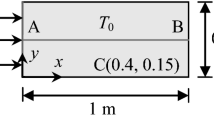Abstract
In the early 1990s, Green and Naghdi introduced a theory attracting interest as heat propagates as thermal waves at finite speed and does not necessarily involve energy dissipation. Another outstanding property of the so-called theory of type II is the fact that the entropy flux vector is determined by means of the same potential as the mechanical stress tensor. Motivated by the procedure of [9, 15], we formulate a variational formulation within the incremental framework for coupled thermoelasticity for type I mimicing type II. The entropy flux of type II is determined via the free energy acting as a potential. This is not possible for the classical Fourier case in the continuous setting. Therefore, we target a derivation of an incremental entropy flux following Fourier’s law by means of incremental potentials similar to the spirit of the theory of the non-dissipative Green–Naghdi-type II. Subsequently, we show that the resulting update algorithm is a convenient fully coupled finite element formulation of the proposed thermoelastic problem.







Similar content being viewed by others
References
Bargmann S, Steinmann P (2005) Finite element approaches to non-classical heat conduction in solids. Comp Meth Eng Sci 9(2):133–150
Bargmann S, Steinmann P (2006) Theoretical and computational aspects of non-classical thermoelasticity. Comp Meth Appl Mech Eng 146(1–3):516–527
Bargmann S, Steinmann P (2007) Classical results for a non-classical theory: remarks on thermodynamic relations in Green–Naghdi thermo-hyperelasticity. Continuum Mech Thermodyn 19(1–2):59–66
Bargmann S, Steinmann P, Jordan PM (2008) On the propagation of second-sound in linear and nonlinear media: Results from Green–Naghdi theory. Phys Lett A (accepted)
Batra G (1989) On a principle of virtual work for thermo-elastic bodies. On a principle of virtual work for thermo-elastic bodies. J Elasticity 21:131–146
Betsch P, Steinmann P (2000) Inherently energy conserving time finite elements for classical mechanics. J Comp Phys 160:88–116
Dascalu C, Maugin GA (1995) The thermoelastic material-momentum equation. J Elasticity 39:201–212
Green AE, Naghdi PM (1993) Thermoelasticity without energy dissipation. J Elasticity 31:189–208
Lambrecht M (2002) Theorie und Numerik von Materialinstabilitäten elastoplastischer Festkörper auf der Grundlage inkrementeller Variationsformulierungen. PhD Thesis, University of Stuttgart
Maugin GA, Kalpadikes VK (2002) The slow march towards an analytical mechanics of dissipative materials. Tech Mech 22(2):98–103
Narayanamurti V, Dynes RC (1972) Observation of second sound in bismuth. Phys Rev 28:1461–1464
Puri P, Jordan PM (2004) On the propagation of plane waves in type-III thermoelastic media. Proc R Soc Lond A 460:3203–3221
Simo JC (1991) Nonlinear stability of the time-discrete variational problem of evolution in nonlinear heat conduction, plasticity and viscoplasticity. Comp Meth Appl Mech Eng 88:111–131
Simo JC, Miehe C (1992) Associative coupled thermoplasticity at finite strains: formulation, numerical analysis and implementation. Comp Meth Appl Mech Eng 98:41–104
Yang Q, Stainier L, Ortiz M (2006) A variational formulation of the coupled thermo-mechanical boundary-value problem for general dissipative solids. J Mech Phys Solids 54:401–424
Acknowledgment
The financial support by the German Science Foundation (DFG) through the grant STE 544/23 is gratefully acknowledged.
Author information
Authors and Affiliations
Corresponding author
Rights and permissions
About this article
Cite this article
Bargmann, S., Steinmann, P. An incremental variational formulation of dissipative and non-dissipative coupled thermoelasticity for solids. Heat Mass Transfer 45, 107–116 (2008). https://doi.org/10.1007/s00231-008-0405-5
Received:
Accepted:
Published:
Issue Date:
DOI: https://doi.org/10.1007/s00231-008-0405-5




